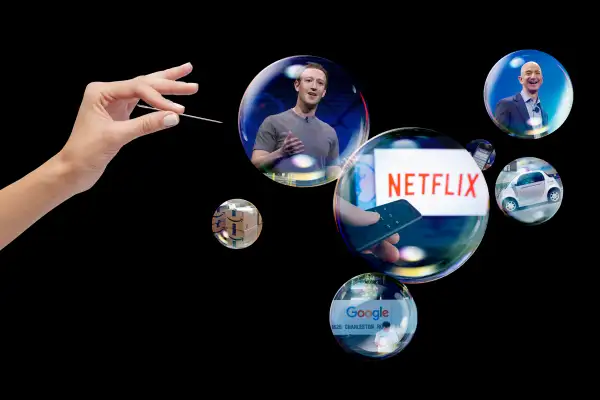5 Signs Tech Stocks Are About to Bring Down the Market Again
Money is not a client of any investment adviser featured on this page. The information provided on this page is for educational purposes only and is not intended as investment advice. Money does not offer advisory services.

Conventional wisdom says this stock market is tame in comparison to the dotcom boom of the late 1990s.
After all, no one is using sock puppets to drum up support for profitless startups—or quitting their jobs to day-trade tech stocks.
And "because investor euphoria is non-existent, an imminent start of a long decline seems unlikely,” argued David Kostin, chief U.S. equity strategist at Goldman Sachs.
Non-existent?
That's a hard one to swallow. Because when you start drilling down and really looking at this market, some startling similarities with 1999's tech craze begin to bubble up. And of course, that boom was followed by a bust starting in March 2000 that eventually erased half of the stock market's total value. It wasn't until this year—17 years after the fact—that the tech stocks in the S&P 500 index fully returned to their dotcom-era highs.
Among the scary echoes:
1. Tech stock returns are insane again.
The late 1990s were filled with examples of tech stocks routinely returning 100% or more in a single year, emboldening investors who thought they could get rich quick.
Today's market is no different.
Just consider a small sample of the tech names that have doubled their shareholders' money or more in just the past 12 months: the semiconductor companies NVDIA, Micron Technology, Lam Research, and STMicroelectronics; the Chinese internet company Weibo; online retailers Alibaba and Overstock; electronic payment processors Square and Wirecard; cloud computing companies Arista Networks and AppFolio; online video game makers Take-Two Interactive Software and Ubisoft Entertainment; e-commerce companies Shopify and Autohome; the internet infrastructure company Extreme Networks; and the internet healthcare company Teladoc.
That's just to name a few.
Over the longer term, things look even crazier. Shares of the streaming video company Netflix have soared 2,500% over the past five years, despite the fact that the company generated fewer profits last year than the comfort-food restaurant Cracker Barrel Old Country Store. The electric automaker Tesla has seen its stock soar nearly 1,500% since the early days of this bull market, despite still being profitless. And the online travel site Priceline is up more than 5,000% since late 2006.
2. Just a handful of the biggest tech stocks are driving the market.
At the early stages of a bull market, the rising tide of improving sentiment lifts the vast majority of boats. But as rallies age, the number of companies that are pushing the major stock market indexes higher tends to narrow.
In the late 1990s, a majority of the S&P 500's movements were driven by a small group of the biggest tech companies in the country. They in turn were led by a group then known as the "Four Horsemen": Microsoft, Intel, Cisco Systems, and Dell.
Today, the names are different. Instead of the Four Horsemen, we refer to the FANG stocks: Facebook, Amazon, Netflix, and Google-parent Alphabet.
Yet the results are largely the same. So far this year, the four FANG stocks plus Apple and Microsoft have accounted for one quarter of all the gains generated by the S&P 500 index of U.S. stocks.
3. Investors are valuing companies with rose-colored glasses.
At first blush, tech stocks may not seem that expensive. The average price/earnings ratio for tech stocks in the S&P 500 index is around 19, based on projected earnings over the next 12 months. That's about a third more expensive than the 10-year average P/E for the sector as a whole—pricey, to be sure, but not completely out of whack with the recent past.
But these sector-wide averages are muted by the fact that a few of the biggest tech names, like Apple and Microsoft, are trading at reasonable valuations.
Peel back the onion and here's what you see:
The average P/E for e-commerce stocks is now roughly 40—double the valuation for the broad market. Amazon stock is trading at a price/earnings ratio of 280. Netflix's P/E is 200.
And several high-flying stocks that have more than doubled their investors' money lately—including Twitter, Snap, Square, and Shopify—didn't generate any earnings over the past 12 months, making valuing those stocks even harder.
"Tesla's stock is priced at $800,000 for every car Tesla has ever produced. Ford, on the other hand, is priced at $6,000 per car it produced just last year," says Rob Arnott, chairman of the investment management firm Research Affiliates.
"So is Tesla worth $800,000 per car ever made? Absolutely," he says—"if all cars are electric 20 years from now, and all of those electric cars are produced by Tesla."
Arnott adds: "If you look around this landscape, gosh, this is very much like 1999."
4. Wall Street and Main Street are brimming with confidence.
Even if you don't think investors are "euphoric," per se, it's hard not to argue that virtually all the participants in the market are supremely confident that the good times are here to stay.
Consumer confidence, investor confidence, and business confidence have all either recently hit all-time or 10-year highs.
When the University of Michigan asked consumers what the "probability of a stock market increase in the next year" was, the average response was around 65%—a record high for that survey.
That survey "reveals that investors have seldom—if ever—been more euphoric in their outlook for the market," noted James Stack, editor of InvesTech Research in his most recent newsletter. "In fact, the percentage of respondents expecting an increase in stock prices is higher than any time since the survey began in 2002...and possibly even as high as the tech bubble of the late 1990s," Stack wrote.
5. People keep saying, 'This time it's different'
Some diehard bulls don't buy it. They point out that this market doesn't feel as psychologically exuberant as 1999.
Still others point out that stock market valuations may not be so worrisome this time, because interest rates remain low. Or that the aging bull market may live on for years because they believe this economic recovery has unfolded so slowly.
In other words, it's different this time.
"So many people are saying it's different this time," says Brad McMillan, chief investment officer for Commonwealth Financial Network. "That's exactly what we saw in 1999 and for that matter 2000. The fact that everybody is saying, 'it's different this time'—I personally don't find that too comforting."
